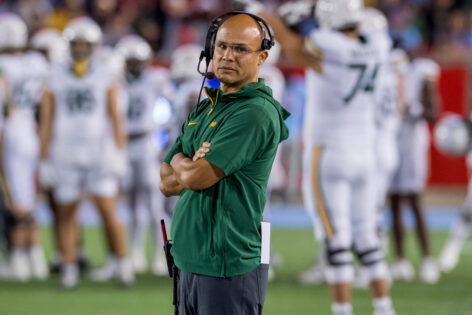Baylor Bears football is off to a strong start this season, aiming to improve on last year’s 8-5 record and chase the glory of their historic 12-2 championship run in 2021. Best part? The new revenue sharing is working perfectly in Dave Aranda’s favor. Lacking the extensive alumni network of other top programs, staying competitive in the NIL era was a tall order, but the House Settlement levels the playing field. And with increased revenue sharing and expanded scholarship opportunities for sports, Baylor is doubling down on football. They’re swinging for the fences and doing everything possible to stay in the national spotlight.
So, what exactly is this revenue-sharing gig? A $2.8 billion settlement revolutionized college sports, enabling Power Five schools (Big Ten, Big 12, ACC, and SEC) to directly compensate athletes under a salary cap. Each school receives $20.5 million, allowing them to invest directly in their athletes. Baylor Athletic Director Mack Rhoades is prioritizing his football team, led by Coach Dave Aranda, for a significant portion of the funds.
Now, explaining the entire approach, Mack Rhoades makes his stance clear on 365 Sports that they are following the revenue-sharing blueprint. “And not to get too complicated, but as a reminder, this settlement had two pieces to it, right? It had the back damages piece, which was settled at just south of $2.8 billion. And within that agreement, it was determined that 75% of that money would go to football, 15% to men’s basketball, 5% to women’s basketball, and then 5% to all the other [sports]. ” That’s what they are going to do, and around $15 million will go straight to their football team.
“So we at Baylor have really taken that formula, and we’re using that in terms of moving forward and how we’ll distribute the “House” money—the $20.5 [million]. We know that number is going to grow every year, but that’s how we’re going to do it—with some nuances and some tweaks,” Rhoades added. Baylor isn’t alone in boosting football revenue.
Clemson, for example, has gone further than most, allocating a remarkable 86% to its football program—surpassing expectations. This reflects a growing trend, as schools compete fiercely. This shift raises questions. Brad Brownell might worry about basketball’s 11% allocation, compared to the typical 15%. On top of that, a few days back, Alabama announced a new partnership with SCOUT, a platform to assist them with a “customized revenue distribution system.”
Baylor initially fell behind in NIL, starting its first year without a dedicated collective—an unusual situation for a Power 5 program. This changed with the launch of GXG, which now manages NIL deals and donations. In February, they added GXG Elite, a fan membership program providing exclusive benefits. A major team-wide NIL deal for Baylor football, reportedly worth seven figures, was secured in October 2022, though details remain confidential.
With a more structured NIL infrastructure now in place, Baylor no longer faces the same challenges in attracting and retaining talent. But with the NIL revenue sharing finally making things better for Mack Rhoades’s team, the expected “5+11” playoff format inconsistencies are making things tough for them.
Rhoades clearing his opinion on the playoff format
College football is moving toward a 16-team playoff with five automatic bids for top conference champions and eleven at-large selections. SEC spring meetings revealed growing support, particularly among coaches, for this 5+11 format. However, expansion depends on the SEC switching to a nine-game conference schedule—a change other leagues might also adopt based on playoff decisions.
SEC officials, including commissioner Greg Sankey, stress the need for clearer CFP selection criteria, especially regarding strength of schedule evaluation. Without transparent metrics, the SEC hesitates to approve a nine-game schedule, fearing a penalty for extra losses against strong opponents. Sankey advocates for a more defined ranking system, balancing fairness with data-driven metrics like ESPN’s SP+ and FPI.
The Big 12 and ACC remain committed to their “5+11” playoff expansion plan. That’s what Mark Rhoades is trying to highlight. “As the Baylor athletic director and a member institution of the Big 12, there wasn’t a lot of debate within the Big 12, and I was, you know, what? I was proud of that because, you know, there’s been a lot of, you know, a lot of conversation about, you know, Big 12 ACC and get automatic qualifiers, get as many as you can because you’re just not sure what you can, what you can, what you can earn. And so I think, you know, for the Big 12, and this was, you know, football coaches and ADs in the same room all together, and they said, ‘No, what’s best for football? What’s best for college football? What’s best for CFP is that, hey, you, earn.’”
Big 12 officials reiterated their support at spring meetings in Orlando, solidifying their alliance with the ACC. Both conferences believe this model fosters meritocracy and broader participation, offering more conferences a clearer playoff path. They also jointly proposed a “4-4-3-3-1+1” alternative to the Big Ten and SEC this spring, but it garnered little attention.
For Mark Rhoades, it’s less about automatic bids and more about teams earning their spots through on-field performance. The new revenue sharing and evolving playoff format make Baylor’s future particularly intriguing.
The post Dave Aranda Receives $15M News from Baylor AD as Stance on SEC& B1G Agenda Cleared appeared first on EssentiallySports.
